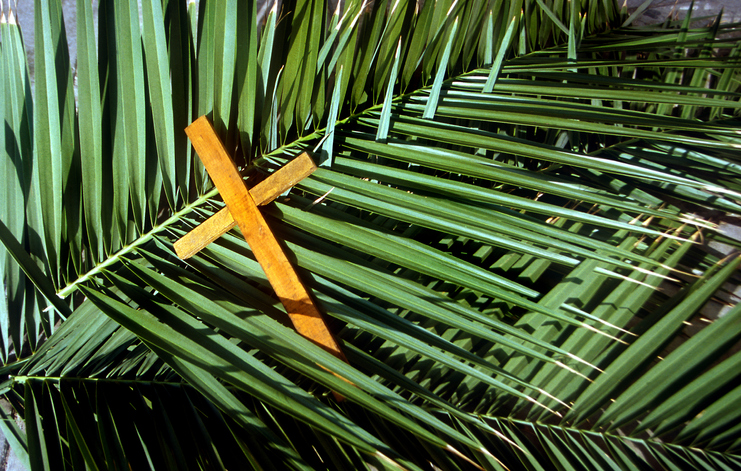
REFLECTION: Liturgy in the public square

An occasional offering from Faith & Leadership, Duke Divinity School’s online magazine on the practice of Christian leadership.
We walked together, some carrying placards, some taking turns carrying the 5-foot-tall cedar cross. Not a large crowd — 25 or so. Enough to be intentional, enough to attract attention. I wore my collar and black cassock, signs of my ministry, signs of the church.
It was Good Friday, and we were walking the Way of the Cross through our town, Carrboro, N.C. This made church public — we felt a little timid and a little bold at the same time.
Somewhere between the fifth and sixth stations, a man rode by on his bicycle.
“F*** God!” he yelled, waving his fist in the air. “F*** religion!”
We walked on.
Good liturgy both expresses and shapes what we believe. That day, the people of my church understood a little better how it felt to publicly claim our identity as Christians, and how a God-made-flesh was vulnerable to the powers of this world.
My congregation, the Church of the Advocate, is a 21st-century mission of the Episcopal Diocese of North Carolina. Launched in 2003, we are rooted in the traditions and liturgies of the Episcopal Church and the Book of Common Prayer.
Because don’t have a building, though, we experience the liberation and the challenge of inheriting the liturgies without the usual structures in which they take place. From the beginning, members of the Advocate have asked, “Why are we doing this? What does it say? How does it form us?”
This has allowed us to consider our Holy Week liturgies from scratch and to take them into new and different places, including outdoors.
In the past year, imposing ashes on Ash Wednesday in public has gained traction in cities and towns as “Ashes to Go.” We have found that the liturgies of Palm Sunday and Good Friday are also conducive to exposure and practice in the world.
After all, that’s where they started.
Palm Sunday
Remembering Jesus’ “triumphal entry” into Jerusalem, we gather as the people of the first century did, outdoors by the walls of the city (in our case, town hall).
Standing in the cool spring air, we hear the story of Jesus, the colt, the people, the palms. And we, too, wave palm branches and carry redbuds, azaleas, daffodils from our own gardens and trees, as the citizens of first-century Jerusalem did with the original palms.
We walk in procession to the entrance of our town commons (home to a playground and a weekly farmers’ market), singing “Jesus is coming! Hosanna! Glory!” I encourage people to crowd as close to the cross as they can.
Before entering, we cast our palms before the crucifer and cross and enter singing, “This child through David’s city shall ride in triumph by; the palm shall strew its branches, and every stone shall cry. And every stone shall cry, though heavy, dull, and dumb, and lie within the roadway to pave his kingdom come.”
The service quickly moves to the Passion story, a liturgical jolt. Yet experiencing these two narratives in one hour helps us realize that we, like the people of first-century Jerusalem, can quickly convert from cries of “Hosanna!” to shouts of “Crucify him!”
All who pass by are welcome to join. Some do: people walking with kids or dogs, people who have never been to church, people who remember the church of their childhood and are intrigued to see it being made new. Some stand on the periphery; others take a seat on chairs we have brought with us.
Good Friday
At noon on Good Friday, we return for a simple service from the Book of Common Prayer. Once again we hear the Passion narrative — the third time in a week — and it begins to penetrate our hearts and our bones. When it’s cold and rainy, we identify with Peter, warming his hands by the fire as he denies he knows the Lord.
Someone brings forth the cross, made of two pieces of cedar lashed together, and we see and feel its heft. We walk to town hall and begin the Way of the Cross/Via Dolorosa with the first station: Jesus is condemned to die.
We have recast the traditional stations for a 21st-century context, so as we walk through our own town, we also reflect on the state of our world, our nation, our community and ourselves. We walk past social service agencies, nonprofits, a center for conflict resolution, the police station, the local food co-op. We realize and make known Christ’s presence in all of these places.
We read the stations in English and in Spanish in recognition of our Spanish-speaking neighbors, many of whom come from countries where the Fridays in Lent are marked by a public procession of the cross. And every year strangers spontaneously join us on the Way, sometimes just for a station or two, sometimes to the end.
Last year we added placards as a way of showing how we were applying the gospel today: “Love the World”; “Jesus Welcomes the Alien and the Stranger”; “Dichosos los Pobres.”
The signs made us feel even more public and vulnerable. We were cheered and jeered. Drivers honked support and annoyance.
Yet when we talked about it afterward, we agreed that we felt strangely empowered and formed as Christians in the world. We realized that we can be open with our faith.
Moving outside the confines of a church building allows us to remember profoundly the experience of Jesus and his followers on the streets of Jerusalem, in the upper room, before the councils of church and state, and on the road to Calvary. And we come to understand more fully Christ’s gift of vulnerability to us all.
The Rev. Lisa G. Fischbeck is the founding vicar of the Episcopal Church of the Advocate, a 21st-century mission in Chapel Hill/Carrboro, N.C.
